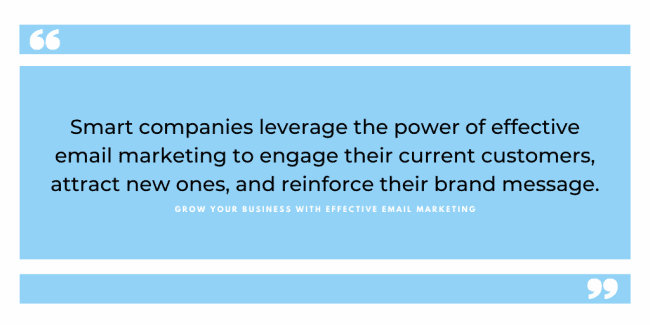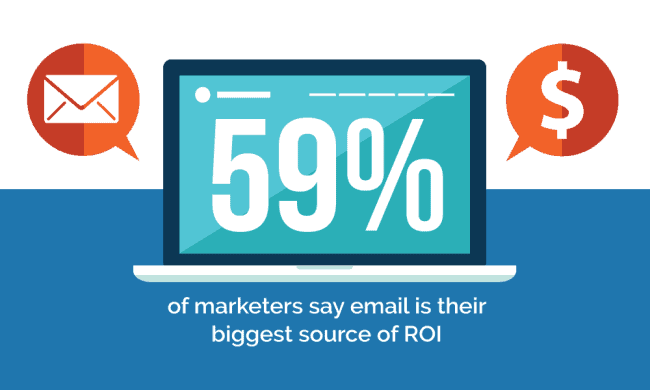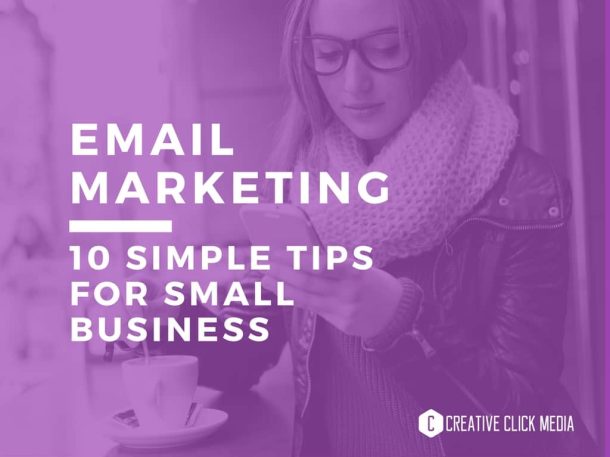Despite all the chatter that email marketing is a thing of the past, it actually continues to represent one of the most powerful and cost-efficient ways of reaching your target audience and delivering your marketing message. Smart companies leverage the power of effective email marketing to engage their current customers, attract new ones, and reinforce their brand message.
This raises two questions; why and how? Let’s start with why.
Penetration
Email has become an integral part of daily life.
According to Statista, roughly 281 billion emails were sent and received each day in 2018.That figure is expected to increase to over 347 billion in 2022. In 2019, the number of global e-mail users topped out at 3.9 billion and is set to grow to 4.48 billion in 2024. Also, Hubspot’s Ultimate List of Email Marketing Stats for 2020 stated that 99% of consumers checked their email at least once a day. No other marketing platform offers penetration numbers like that.
 Reach
Reach
‘Reach’ defines the percentage of your targeted market that your marketing message, well, reaches. Email marketing affords a reach that far surpasses other digital marketing tools.
Let’s imagine a company with 2000 Facebook followers. It is said that their ‘potential’ reach is 2000. However, potential and actuality are two very different beasts. Of the 2000 followers who may potentially view a social media post, only a small percentage (about 26%) will actually see it. Even less will respond, comment, or take action as a result. While this imaginary company’s ‘potential’ reach may be 2000, its actual reach is only 520.
Now let’s imagine a company that sends out 2000 marketing emails. An average of 18% of the emails will get blocked or fail to deliver, and another 4% will end up in the dreaded’ spam’ folder. While that represents a fail rate of 22%, it also represents a hit rate of 78% and a penetration of 1,560; nearly 300% more than a social media post.
Shelf Life
Here’s a phrase you’ve probably heard, “Once it’s on the internet, it’s there forever.”
It’s a fairly common idea, one repeated by parents trying to encourage their children to be responsible in their use of the internet. However, that isn’t really true. Content uploaded to the internet is not permanent. Websites shut down or get hacked, domain names are bought and sold, and the greater majority of the content uploaded to the internet will be lost to the digital winds of time.
And even if the internet was ‘forever’, after a certain point, who cares?
75% of all Facebook impressions are made in the first two and a half hours. That means that once the golden 2.5-hour mark is crossed, the effectiveness of a marketing message delivered via Facebook plummets. Tweets are even more temporary, with an effective life-span measured in minutes.
Email marketing, on the other hand, is like a Highlander; it’s never going to die unless it is actively killed. An e-mail just sits there in a recipient’s inbox, waiting patiently to be opened and read. It is this characteristic that provides email marketing with a much longer ‘shelf-life’ than other digital marketing channels.
Return on Investment
You may want to hold onto your seats for this one.
4,200%.
According to Litmus’ 2019 research featured in Hubspot’s Not Another State of Marketing Report, that’s the average return-on-investment for an email marketing campaign. To put that into straight dollars and cents, every $1 you spend on email marketing has the potential to make $42. That level of ROI is incredibly rare across any medium, and yet it merely represents the standard for email marketing. Hubspot also cited EMMA’s 2018 Email Marketing Industry Report which found 59% of marketers say email is their biggest source of ROI.Target your campaign effectively, develop a catchy headline, and provide some quality content, and the sky is the limit for your ROI.
Putting the time and effort into developing an effective email marketing campaign can pay huge dividends for smart businesses and marketers. Whatever your marketing message, e-mail marketing provides deep penetration, wide reach, a longer shelf life, and an unbeatable ROI.
 Effective Email Marketing
Effective Email Marketing
So, now that you understand why email marketing is a great way to grow your business, it’s time to understand how to create an effective email marketing campaign. In today’s competitive market, the goal is to stand out from the crowd. That takes more than a simple email. When creating your next email campaign, there are some things to consider.
Integration
Your email campaign should be an integral part of your overall marketing strategy.
However, many business owners fail to do this. Email marketing can provide valuable insights into your audience beyond just the basic measurable metrics such as likes, shares, and impressions. These insights are unique and can be a valuable resource for optimizing all your marketing efforts.
For example, let’s say you send out an email with a killer subject line that sends your open rate through the roof. You could use similar language in Facebook Ads or other paid advertising. Maybe you’ve sent out an email promoting a recent blog post and it received a record click-through rate. That means that the topic resonated with your audience and your content and social media teams need to know about it.
They should be asking themselves “How can we capitalize on this?”.
It might be beneficial to create more social media posts about that topic or additional blogs on relevant sub-topics. The correct action will differ depending on the topic but a big win in your email marketing can easily translate into a win for your other marketing campaigns as well. The insights gained need to be properly communicated between teams. Here are a couple of tips on how to make that happen.
You can start by making email marketing reporting dashboards available to your entire organization. This will allow them to see which campaigns were most successful and figure out how to apply the components of those highly effective campaigns to their own marketing efforts. It can also be helpful for the email marketing team to write a report on the insights they derived from the campaign results. Monthly meetings to share reports and insights from all marketing departments can also be an effective way to ensure they are being thoroughly utilized.
Segmentation and Personalization
Are you currently sending the same email campaign to your entire audience?
If so, you’re not doing your audience or yourself any favors. Traditional one-size-fits-all campaigns are no longer enough to generate maximum engagement with your audience. Personalization is the key to making a connection. Your list of contacts should be more than just their names and email addresses. You need to make them feel as though the email was created specifically for them.
To start, use merge tags. This means the recipient will receive an email that addresses them by name. Next, segment your contact list by their interests, past purchases, and preferences as well as demographic information. For example, a sporting goods store is going to have a sale on golf clubs. An effective email marketing campaign should target the golfers in their audience and contain language specific to the sport. Something like – “Our Annual Golf Club Sale is a Hole-in-One.”
According to MailChimp’s Email Marketing Benchmarks by Industry 2018, emails related to hobbies are among the most opened emails, with an open rate of 27.35%. These are topped only by government related emails at 28.77%. The average open rate for all industries analyzed was 21.33%. If the sporting goods store sends the “Golf Club Sale” email to its entire list, it will be tough to reach the average open rate much less beat it.
There are a couple of different methods used to segment your mailing list. One option is to make individual lists for each segment of your audience. Many email marketing platforms such as MailChimp and Constant Contact allow you to create one list and tag your contacts according to their interest or preferences. This method can simplify the process. Then when it’s time to send a campaign, you can send it just to the lists or tagged contacts that would find it of interest. In addition to personalization and segmentation, an effective email marketing campaign should also be mobile friendly. Statistics released by Litmus in 2018, stated that 46% of all email opens were completed on mobile devices.
 Experimentation
Experimentation
The technology that drives email and all digital marketing is constantly evolving. Your email marketing efforts need to evolve as well for your business to remain competitive.
Let’s start with email automation. While not a new email marketing tool, it’s one many business owners overlook, fearing it will be too difficult. Again, most email marketing platforms have automated sequences that are easy to create and customize. These can be extremely valuable for creating drip campaigns, automated abandoned cart reminders and more.
Moving on, there are a few other email marketing trends to consider.
Interactive emails are a rising trend in email marketing. They are pretty much what the name implies and include features the recipient can interact with, creating an experience. These features can include surveys, carousel product displays, add-to-calendar options, animated CTAs and more. Interactive emails allow the recipient to follow your campaign objective without leaving their inbox. They also enable you to pack more information into a single screen, eliminating long, drawn out emails that can have a recipient clicking out before they even finish reading it.
Incorporating user generated content into your emails can be a great way to build credibility with your audience. User generated images, comments and reviews provide proof that the services and products you’re offering are used and enjoyed by real people. This can encourage others in your audience to give your offerings a try.
With the sheer volume of emails consumers receive every day, an effective email needs to include elements that make it stand out from all the rest. Videos, animations and GIFs can add movement to your emails and grab subscriber attention.
Allowing subscribers control of how often they receive emails from your business or organization might not be the first thing you think of when creating an effective email marketing campaign. However, an eMarketer article cited a 2018 Alliance Data study which found that 52% of consumers felt when they controlled the frequency of communications received from retailers, the more likely they were to pay attention to them. The same article cited a 2019 Harris Poll survey which found that 42% of adult consumers in North America and the UK said they feel like an individual when companies enable them to customize and control their brand interactions.
These statistics just reinforce the need for personalization in your email marketing campaigns This can easily be done with a welcome email for new subscribers that allows them to choose the types of emails they want to receive and the frequency of those emails. You can also periodically send out an email that allows all users to update their preferences.
Not sure any of these suggestions are right for your email marketing? There’s only one way to find out.
If you’re struggling to get results from your email marketing efforts, the team at Creative Click Media is ready to help. We offer competitive, professional email marketing solutions to grow your business. Ready to get started? Let’s talk.





